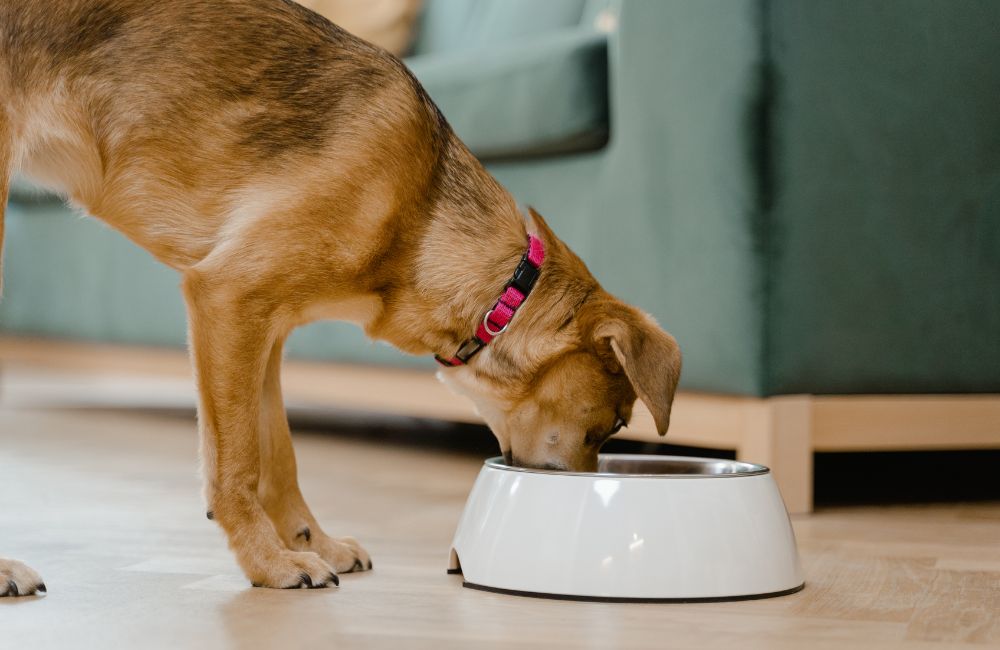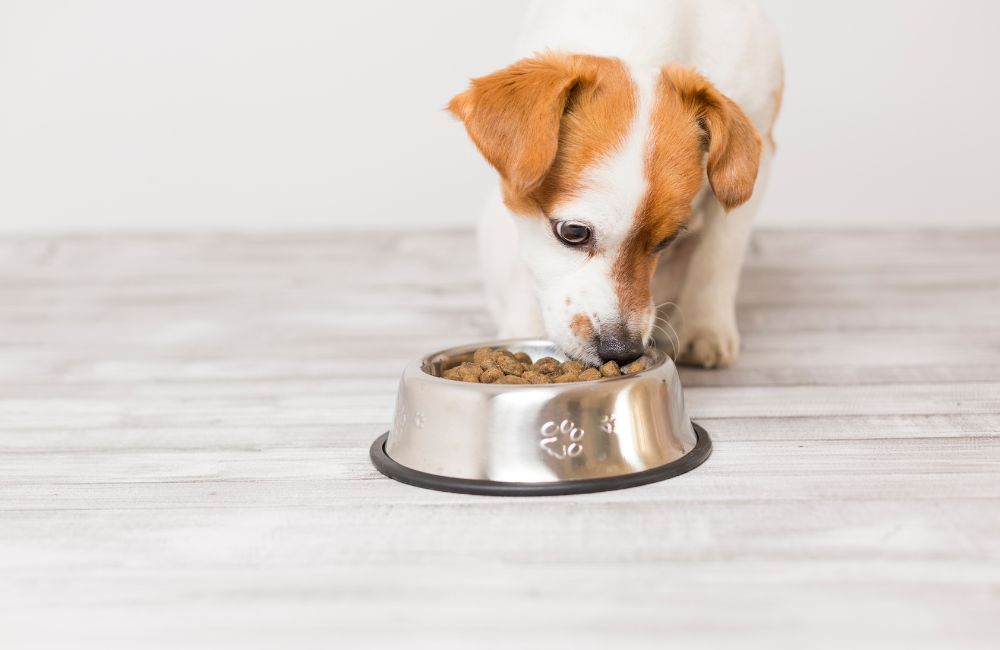Dogs trust us to keep their bowls and treat jars safe. The wrong snack can trigger stomach upset, poisoning, or worse. New pet parents often ask, “What can dogs not eat?” Clear rules and quick actions make all the difference. This guide lists the big no‑nos, safe alternatives, and what to do in an emergency.
Contents
Key Takeaways
- Keep a visible “do not feed” list and teach family rules to prevent accidental poisoning and choking hazards.
- Dose and concentration drive risk, so even a small bite of dark chocolate, xylitol gum, alcohol, or grapes can be dangerous.
- If exposure happens, remove access, capture the product details and your dog’s weight, and call your vet or a poison helpline immediately.
The Big List of “No” Foods for Dogs
Some human foods can harm dogs quickly. Keep this list near the fridge. Please share it with family.
Chocolate and cocoa products
Chocolate contains theobromine and caffeine. These stress the heart and nervous system. Dark and baking chocolate hit hardest. Signs include vomiting, restlessness, and fast heart rate. Choose carob dog treats instead.
Grapes, raisins, and currants
Even tiny amounts can trigger kidney failure. Sensitivity varies, so no amount is safe. Watch for vomiting, lethargy, and reduced urine. Offer blueberries or apple slices without seeds.
Xylitol in gum, candy, peanut butter, and baked goods
Xylitol can cause a rapid drop in blood sugar. Seizures and liver injury can follow. Check labels on peanut butter and mints. Pick xylitol‑free peanut butter made only with peanuts.
Onions, garlic, chives, and leeks
Alliums damage red blood cells and cause anemia. Small amounts over time still add up. Signs include weakness and pale gums. Use plain cooked meats or carrots for flavor.
Alcohol, unbaked yeast dough, and raw batter
Alcohol poisons quickly and depresses breathing. Rising dough creates gas and can bloat the stomach. Raw batter may carry pathogens. Keep dough covered and out of reach. Share a dog biscuit instead.
Caffeine sources, energy drinks, and tea leaves
Caffeine overstimulates the heart and brain. Problems include panting, tremors, and irregular heartbeat. Tea leaves and coffee grounds are risky too. Stick to fresh water or dog‑safe broth.
Macadamia nuts and high‑fat leftovers
Macadamias can cause weakness, tremors, and fever. Greasy scraps raise pancreatitis risk. Symptoms can appear within hours. Offer lean meats or green beans as treats.
Cooked bones, skewers, and corn cobs
These can splinter or block the intestines. Perforations are a life‑threatening emergency. Never leave plates within reach. Choose vet‑approved rubber chews instead.
Excess salt, seasonings, and ultra‑processed snacks
High sodium dehydrates and upsets the gut. Seasonings may hide onion or garlic powder. Chips and similar snacks add empty calories. Give plain, unseasoned dog treats or crunchy veggies.
Get Joy Dog Food: The Safer and Nutritious Meal
Get Joy focuses on gut health with vet‑formulated fresh meals, freeze‑dried raw recipes, treats, and supplements. Its Belly Biotics blend adds prebiotics, probiotics, and postbiotics to support digestion and overall wellness. Meals use USDA meats with gently cooked or raw options and ship to your door, with clear transition instructions for new feeders.
Why It is Good For Your Dogs:
- Supports healthy digestion via prebiotics, probiotics, and postbiotics in Belly Biotics
- Helps strengthen immune function and manage inflammation
- Promotes regular stool consistency with fiber‑rich ingredients like pumpkin
- Provides balanced proteins using USDA meats in fresh or freeze‑dried formats
- Eases switching foods with step‑by‑step transition guidance and home delivery
Want to upgrade your dog’s bowl responsibly? Talk to your vet, then explore Get Joy’s fresh or freeze‑dried plans to match your pup’s needs and build gut health today safely.
Dose Matters and Why a “Small Bite” Can Still Be Harmful
Toxicity depends on body weight, concentration, and the dog’s health. A tiny piece can be a big dose for a small breed. Dark chocolate, xylitol gum, and alcohol are highly concentrated. Even a bite can push levels into danger.
Grapes and raisins are unpredictable, so any amount is risky. Alliums build up damage over time, so small nibbles add up. Fatty scraps can trigger pancreatitis in one sitting. Hidden ingredients raise the risk, too.
One spoonful of batter might include xylitol or alcohol. Uneven mixing means a “small bite” can hold a large load of toxin. Puppies, seniors, and sick dogs have less reserve.
Absorption can also be fast, which shortens your reaction window. When in doubt, treat it as exposure and call your vet. Keep human foods out of reach, and teach guests the house rules. Prevention beats emergency care every time.
Junk Foods Dogs Can Eat In Tiny Amounts
Some human snacks aren’t toxic but still aren’t suitable for dogs. If you allow any, keep portions tiny, give them rarely, and choose plain versions. Safe-ish examples include air‑popped popcorn without salt or butter, small pieces of plain bread or pizza crust with no garlic or onion.
These foods don’t add real nutrition and can crowd out balanced meals. Use them only when training or as an occasional treat. Watch your dog closely afterward for any signs of stomach upset. Call your vet if anything seems off. When in doubt, pick a dog‑specific treat with a short ingredient list.
- Can drive weight gain and obesity
- May cause vomiting, diarrhea, or gas
- Raises risk of pancreatitis with high‑fat items
- Adds excess sodium that stresses the heart and kidneys
- Contributes to dental plaque and bad breath
- Teaches begging and food guarding behaviors
- Can mask hidden toxins like onion, garlic, or xylitol in processed foods

What To Do If Your Dog Eats a Banned Food
Speed matters when a dog eats a banned food. Stay calm, gather facts, and call a professional to reduce risk, avoid guesswork, and guide next steps.
Identify What, When, and How Much
Remove the item and keep every bit of packaging. Check the trash, counters, and floor for missing pieces. Estimate the maximum your dog could have eaten, not the minimum. Note the time window, your dog’s weight in kilograms, age, breed, and any health issues.
Take clear photos of the product label, ingredient list, nutrition panel, and what’s left. Record new symptoms with timestamps. This gives your vet a fast dose‑per‑kg estimate and guides treatment.
Remove Access and Limit Absorption
Block your dog from the area and any crumbs. Crate or move them to a safe room. Wipe lips, tongue edges, and paws with a damp cloth to remove residues.
Rinse the mouth lightly only if your vet says it’s safe. Don’t give food, milk, oil, or over‑the‑counter remedies. Skip activated charcoal unless a veterinarian directs it. Reducing further exposure buys crucial time.
Call a Vet or a Poison Helpline Now
Call your veterinarian or a pet poison helpline immediately. Have the product name, ingredients, suspected amount, time since exposure, and your dog’s weight ready. Mention meds your dog takes, recent illnesses, and pregnancy or nursing status.
Ask if you should come in now or monitor at home. Follow instructions exactly and keep your phone nearby for callbacks. If symptoms start or worsen, head to the clinic.
Don’t Induce Vomiting Unless Told
Vomiting isn’t always safe or helpful. Caustics, oils, sharp objects, and foaming or expanding items can cause more harm on the way back up. Ask a question and get an answer from a verified expert veterinarian on Ask A Veterinarian to know if its safe to induce vomiting. Breathing trouble, seizures, collapse, or brachycephalic anatomy raise aspiration risk.
Some toxins move fast, so waiting to try home methods can waste treatment time. Use 3% hydrogen peroxide only if a vet instructs you and provides the exact dose and timing. If vomiting is needed, your vet can use safer, controlled medications.
Caffeine Beyond Coffee: Tea, Energy Drinks, and Pre-Workout Mixes
Coffee isn’t the only caffeine risk for dogs. Tea, energy drinks, and pre-workout mixes can trigger dangerous stimulation. Know sources, common symptoms, and right first steps to keep dogs safe.
Tea and Matcha
Black, green, oolong, and matcha all contain caffeine. Matcha is powdered, so it delivers more per sip. Iced tea isn’t safer. Decaf still contains small amounts. Some “herbal” blends include green or black leaves. Used tea bags tempt dogs and can release caffeine when chewed. Keep bins sealed and mugs out of reach.
Energy Drinks and Shots
Energy drinks and shots pack concentrated caffeine. A single small can can equal several cups of coffee. Guarana often appears on labels and adds extra caffeine. Sugar-free versions may contain other sweeteners dogs shouldn’t have. Spills on floors, open cans in cars, and straws left in bags create easy access. Store high.
Pre-Workout Powders and Capsules
Pre-workouts often use caffeine anhydrous in high doses per scoop. Some add stimulants like synephrine or yohimbine that can worsen agitation. Dogs sniff shaker cups, lick powder on gym bags, and chew capsules. Dry powder absorbs fast and hits quickly. Rinse gear right away and keep tubs snapped shut in cupboards.
Signs and Immediate Steps
Early signs include restlessness, pacing, vomiting, panting, drooling, and rapid heart rate. Tremors or seizures signal an emergency. Remove access, take the label or a photo, and note how much might be missing. Call your veterinarian or a pet poison helpline immediately. Don’t induce vomiting unless a professional tells you to.
Conclusion
Keeping dogs safe starts with clear rules about people food. Learn the common offenders, post a “do not feed” list, and share it with family and guests. Check labels for xylitol, onion, garlic, alcohol, and other hidden risks. If you’re unsure, ask your vet and stick to dog‑specific treats. When you think “what can dogs not eat?”, choose caution first and you’ll protect your best friend every day.
A healthy pet can make its owners healthier. Know why with this article!
FAQ: What Can Dogs Not Eat
- Are sugar alcohols like erythritol, sorbitol, and maltitol safe for dogs?
- Xylitol is extremely dangerous and can cause a rapid insulin spike. Other sugar alcohols don’t trigger the same effect but can still cause vomiting and diarrhea. Skip sugar-free products unless you can confirm there’s no xylitol.
- Can dogs have cannabis edibles or CBD gummies?
- THC is toxic to dogs and gummies make dosing unpredictable. Many edibles also contain chocolate, raisins, or xylitol, which compounds the risk. Call your vet or a pet poison helpline if ingestion happens.
- Is raw bread dough dangerous?
- Yeast dough expands in the stomach and can cause painful bloat. Fermentation produces alcohol that can lead to ethanol poisoning. Keep proofing bowls, discarded dough, and trash out of reach.
- Do grapes or raisins become safe once cooked or baked?
- Heat doesn’t remove the toxin linked to kidney failure. Cookies, breads, and trail mixes stay hazardous even in small amounts. Avoid products with grape derivatives like raisins, currants, or sultanas.
- Which seasonings and aromatics are most concerning?
- Onion, garlic, leeks, and chives can damage red blood cells, and powders are especially potent. Broths, gravies, marinades, and baby food often hide these ingredients. Choose plain, unseasoned meat if you want to share.



